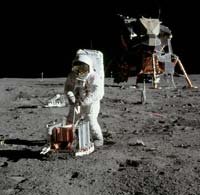News
Seismic recording marks first Moon walk
Published:27 June 2014

Edwin 'Buzz' Aldrin positions the
passive seismic experimental
package on the surface of the
Moon in July1969.
Copyright NASA
When Neil Armstrong and Edwin 'Buzz' Aldrin were enjoying the special experience of being the first humans to wander on the surface of the Moon in July 1969, they were also creating something unique - the first lunar seismic event registered on Earth.
The event was part of an experiment at Tranquillity Base in which the astronauts positioned a passive seismic experimental package containing a long-period seismometer and a short-period vertical seismometer for measuring meteorite impacts and moonquakes. The experiment was activated on 21 July 1969 and ceased operating on 27 August 1969.
The outcome was a seismic signal of the astronauts footsteps transmitted to Earth receiving stations as they walked across the lunar surface carrying out experiments. As well as the astronauts' footsteps as they walked on the Moon, the seismogram shows the impact of the astronaut's life support systems as they were thrown from the Apollo-11 lunar module and struck the surface.
Now, in a fresh experiment, Geoscience Australia technician, Trevor Dalziell, has obtained the original transmitted data and reproduced the seismogram on a Teledyne Geotech Helicorder.
The resulting printout from the Helicorder is currently on public display at Geoscience Australia on a banner which includes images of 'Buzz' Aldrin deploying the instrument which were taken by Neil Armstrong.
For people wanting to see a recreation of the seismic event on a Geotech Helicorder, Mr Dalziell will give a demonstration at the Questacon event, Apollo-11 Canberra's Vital Role on 20 July 2013 and at Geoscience Australia's Open Day on 18 August 2013.
Email:




